How Many Lbs of Feed Cornish Cross
Learn how to set-up your Cornish Cross broiler operation for versatility and efficiency. Anne Gordon shares her tips so your set up can reduce and even eliminate health issues and the sudden death "flip." [Unless otherwise noted, all photos by author]

Each spring and fall, I raise a batch of 25 Cornish Cross pullets. My feed conversions are typically at or below breeder benchmarks with 8.5 pound live-weight pullet broilers at 8 weeks which dress out at 5.5-6 pounds each. For the most part, my success comes from close adherence to commercial broiler growth techniques and years of developing a smart set-up strategy.
Cornish Broiler Basics
The Cornish Cross broiler is very different from traditional layer or dual purpose chickens. Decades of hybridization have produced a meat bird that is incredibly efficient at converting feed to body mass. Cornish Cross hens can grow to eight pounds in as little as eight weeks. Look at it this way, Bresse, Buff Orpingtons, Buckeyes, and Chantecler chickens all mature around 7 to 9 pounds but it takes them 16 to 21 weeks to get there, twice the time of the Cross and twice the feed.
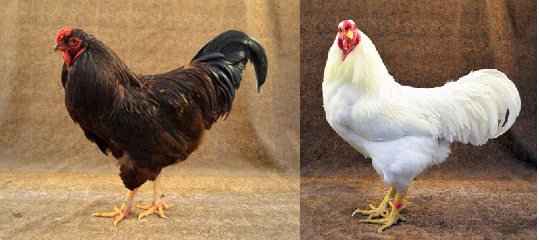
Buckeye and Chantecler roosters.Photos courtesy of the Livestock Conservancy.
Because breeding efforts have emphasized breast meat development, the Cornish Cross broiler's center of gravity is farther forward from the more upright layer or dual purpose chicken. This makes it difficult for them to evade predators quickly and run across uneven ground. These broilers are not bred to be athletic or particularly active. Driven by their increased metabolism they focus most of their attention on eating. Which means that their feed schedules, care, and general management needs to be different from raising layers, and even slow-growth dual-purpose birds. They also need a specific physical environment to protect them from predators. Below, I'll walk you through how I use wire pet pen panels for a versatile set-up that I can then pack away after each batch of 25 have been processed. If you'd prefer to use a permanent set up, you might consider building a movable tractor and still using my suggestions for setting up a run.
The Results of Research
It's been said that if you want to be rich, you need to consider how the rich got rich. The same holds true for the Cornish Cross broiler. Thin profit margins and competitive prices have influenced how commercial growers raise Cornish Cross broilers. Decades of research and trials have resulted in proven methods of reducing costs and risks while optimizing the health and growth of the Cornish Cross broiler. Many of these methods are worth adopting into small flock operations. Mortality, disease, and underweight broilers are simply not profitable for the commercial grower or the small flock owner.
A Space of Their Own
Cornish Cross broilers do not require the physical space of layer or dual-purpose chickens. Like layers and dual-purpose chicks, the broiler chick up to 3 week of age does not need much more than a square foot of brooder space. This is where the similarities end. Growing broiler pullets and cockerels need only 1 to 3 square feet of space but require larger feeders and waterers (and space for them) because of their fast growth rate. Their voracious appetite can sometimes cause bullying at the feeder and an empty waterer can cause digestive disruptions and even crop impaction. In my experience, I don't find Cornish Cross broilers to be very resilient creatures. They require steady, consistent care.
Efficient and Versatile
My poultry setup includes a walk-in coop attached to a 10-by-30-foot covered, metal-roof run, separated into two sections – a 10-by-20-foot run with access to free range pasture for the layers and another 10-by-10-foot pen used for breeding, quarantine/hospital or broiler chick grow out. You can read more about how Anne uses and stores her whole set-up here.

There is a 3-foot apron of ½-inch hardware cloth surrounding the entire structure as predator proofing. As designed, this set-up is easy to clean (eliminating odors), easy to access chickens, looks nice, and offers flexible functionality.
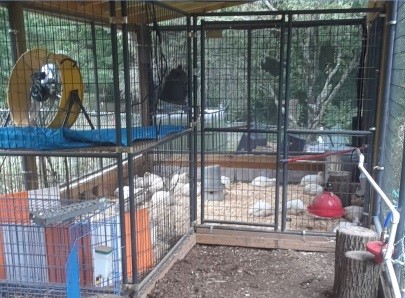
This is the coop set up when all the panels are snapped together.
Wire panels
I don't really have enough yard space for raising and finishing Cornish Cross broilers in a separate coop or yard. Because I'm only raising chickens for 16 weeks out of the year, I want to limit the equipment I use and be able to store it all easily for the rest of the year. This is why I'm a huge fan of wire pet exercise panels. They are easy to use, quick to set up, simple to store, and a perfect solution for multiple uses with chickens.
Using a couple wire exercise pens, I can set up a temporary covered brooder with small run in my carport so I can keep a close eye on chicks. As they grow, I can add a second, shorter pen as a daytime run. The main wire pen is wrapped in ½-inch hardware cloth to keep out rodents and snakes. I can set up the brooder and run in 20 minutes or less.
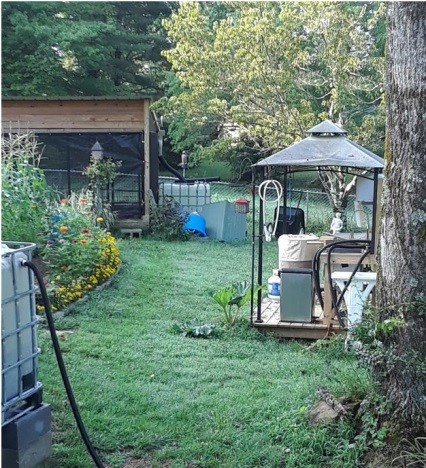
You can see the coop run set up in the back of this photo, 60 feet from my house.
The Set-up in Detail
– I often pair layer chick replacements with the Cornish Cross chicks and this year raised 15 Plymouth Rock with them for a total of 40 chicks. This brooder set up provides roughly 28-square-feet or ½ square-foot of space per chick.
-The brooder space is supplemented by a small attached daytime run bringing total square footage up to about one-square-foot per chick.
-A 5-quart waterer along with a 7-pound feeder is kept full and available in the brooder.
– A vitamin, mineral and electrolyte/probiotic supplement is added to the water from hatch through the end of the 3rd week.
– AT the far end of the run, I place a hanging waterer and 3-foot trough with spinning reel that discourages perching (and the inevitable manure in the feed) are placed in the attached pen at 3rd week.
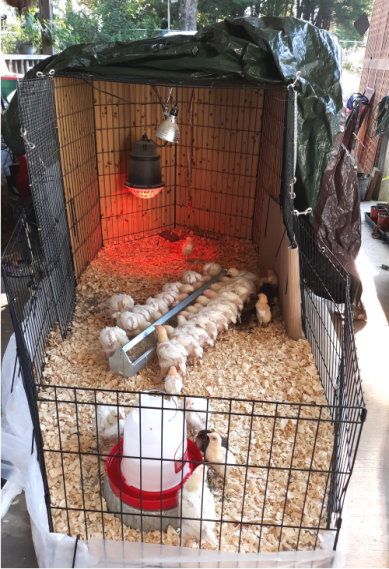
Forty-five Cornish Cross and layer chicks at the start of the 3rd week.
– As recommended by major breeder grower guides, I also provide a white light along with heat lamp in the brooder. The small 5 ½-inch clamp lamp with a 4-watt LED nightlight bulb provides just enough white light for the broiler chicks to see both feeder and waterer throughout the night to encourage feeding.
The Grow Out Pen
At the 4th week, chicks are moved to the grow out pen and their sleep house. You can make a round or rectangular pen by attaching the two to three end panels with snap clips. I put this pen on a raised plywood floor (which can be cleaned and reused) and add a plywood top to transform the wire pen into a secure sleeping house. Because of rapid weight gain and changes to their center of gravity due to breast meat development, Cornish Cross broilers do not roost. Instead, they sleep huddled together on the ground. The broilers will retreat into the sleep house at dusk on their own.
Thirsty and Hungry Girls
At the end of the third week, transition the chicks off the electrolyte and vitamin mix and onto plain water. I use a red, auto bell drinker (which is the same color as the previous waterer.)
At the same time, I swap their feeder for a 3-foot trough that provides enough space for the growing chicks to all eat side-by-side at the same time. The chicks adapt easily when these changes are all made at the same time rather than spreading them out.
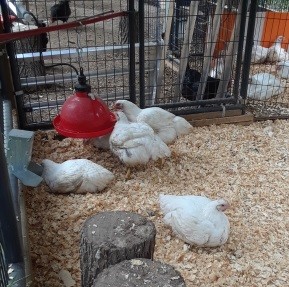
Broiler chicks easily adapt to the Auto Bell Waterer
The 4th week also marks the beginning of a 12-hour full feed and 12-hour feed restriction rotation. The purpose of this is to limit too rapid growth. At the same time, the smaller white light is removed. Cornish Cross birds have been bred to eat and they will keep eating if there is food available. If they grow too rapidly, they can suffer heart attacks, develop ascites and bone problems resulting in lameness or broken bones. So I use a physical feed restriction program of supplying enough food for a 12-hour period, and then removing their food for 12 hours.This is the same method used by some commercial operations.
After 12 hours of feed restriction, you could be mowed over by those little chicks barreling out of the brooder in search of the feeder. To avoid congestion around the feeder, the 3-foot trough gives the chicks just enough space for everyone. If all the chicks are packed pretty snugly around the trough, they tend to drop less food outside of it (lower food waste) and the less they jockey for a seemingly "prime" position. They all just focus on eating. I replace the 3-foot trough with a 4-foot trough when the growing chicks are crowded enough to start pushing each other away. The revolving reel across the top of the feeder keeps the young broilers from standing on the feeder and pooping in the trough. Less soiled feed means less wasted feed.
The Right Shaped Feeder
While traditional round feeders work well for layers, they really aren't adequate for Cornish Cross broilers. One study found Cornish Cross broilers approach a feeding trough up to 50 times in 24 hours. For optimum growth and weight gain, feed much be easily available to all the broilers at the same time. Traditional round feeders can't serve more than 10 birds at a time. Chose the type of feeder that will work best for the number of broilers you have.
Reducing Waste
Reducing food waste helps with your bottom line. Limiting dropped food limits the snakes and rodents who sneak into your coop at night to snack.
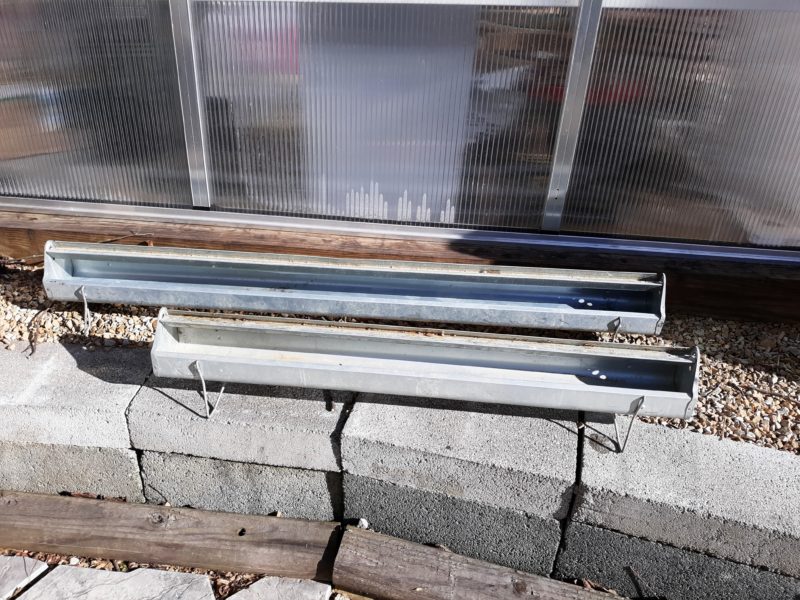
Galvanized steel trough feeders have a revolving reel across the top, to prevent young broilers from roosting and fouling their food.
Easy-Peasy Cleaning
Before relocating the chicks to the grow out pen, I prepare the ground by spreading a 50/50 mixture of baking soda and flour in the run. Over that mixture, I lay down a 3- to 4-inch deep layer of pine flake litter, both inside the sleep house and in the pen. The pine flake litter absorbs moisture and provides odor control. Keeping the litter fresh is as easy as fluffing and adding a little more over the last five weeks the broilers are confined. Like the deep litter method, this approach also encourages microbes to grow in the litter to destroy the coccidian parasites found in manure.
Cleaning out the sleep house is as easy as unclipping the wire panel ends where they join and spreading them open. A couple of passes with a wide snow shovel quickly scoops up the litter and the sleep house is clean.
Keeping Pens Dry
You'll need to increase the frequency of your cleaning during the 6th to 8th week as their metabolisms will be in full swing and they will be eating a lot and producing lots of wet manure. Continue to mix some flour and baking soda with your pine flakes to limit odors. If the pen gets too wet from watery poop or rain, you can also use pine pellets (like the ones used in horse stalls) to absorb extra moisture.
A broiler that sleeps or lie on moist ground or grass with on fresh manure with high ammonia develops breast blisters. This condition starts as feather loss and red, irritated skin similar to diaper rash that eventually leads to painful blisters that lead to bacterial infection.
Anticipating Feed Needs
We've talked a lot about how fast broilers grow, which means that they do need to consume quite a bit of food each day. At 21 days, each bird will eat about ¼ pound of food a day. By the time they are 49 days old, they are eating ½ pound a day. Applying this math to the birds I have means that 25 Cornish Cross boilers and layers will eat about 325 pounds of feed over 8 weeks. I like to buy all of the 22% broiler feed I'll need before I move them into the grow out pen and keep it in galvanized steel-covered cans inside the pen. This makes it easy to pop off the lid and measure out food into their trough.
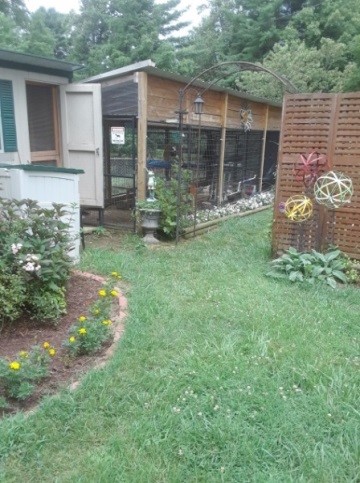
End 10-foot-by-10-foot section of chicken run used for Cornish Cross grow out is within 60 feet of my back deck – No Stink!
Deep litter, auto waterer, pre-calculated food needs, snap together fencing, planning ahead – all make for just a few, quick chores each day to raise enough broilers in 16 weeks to feed your family for the year.
Anne Gordon is a backyard chicken owner with a modest chicken operation that includes layer chickens and Cornish Cross broilers. And, like many of you, she doesn't sell eggs or meat – all production is for her personal consumption. Anne's a long time poultry keeper and writes from personal experience as a city girl who moved to the suburbs to raise a few chickens and now resides on a rural acreage. She's experienced a lot with chickens over the years and learned lots along the way – some of it the hard way. Anne's had to think out of the box in some situations yet held to tried and true traditions for others. Anne lives on Cumberland Mountain in TN with her two English Springers Jack and Lucy. You can follow her doings through her website Life Around the Coop .
Source: https://www.communitychickens.com/cornish-cross-success-zw01912ztil/
0 Response to "How Many Lbs of Feed Cornish Cross"
Postar um comentário